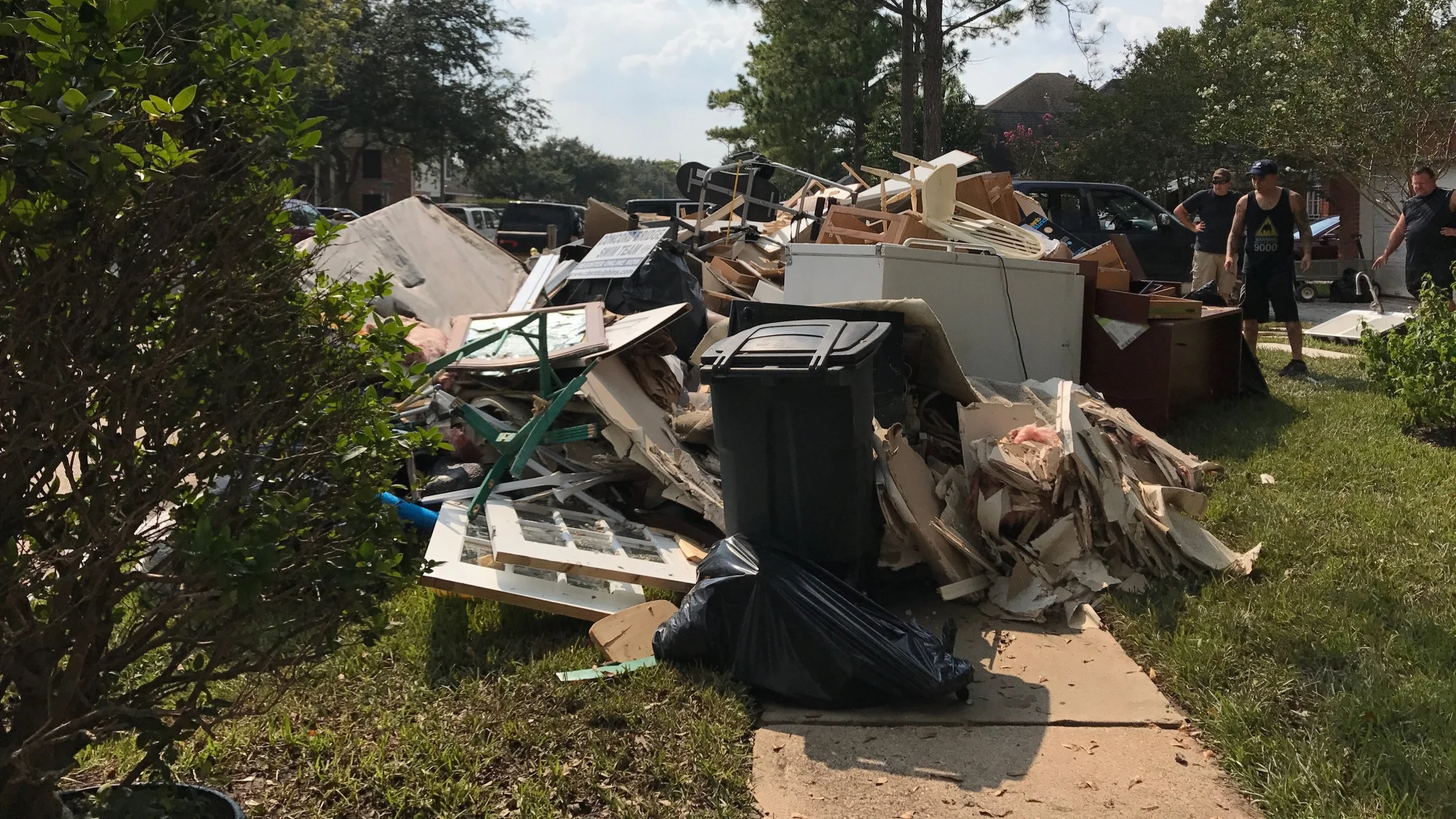Stuff Purging and Wishing for Hindsight
The aftermath of Hurricane Harvey in a Houston suburb. September 4, 2017.
Spring always comes as a gorgeous relief: Blooms high and low, warm breezes mixed into crisp air, sunlight lingering into the evening. The last thing I want to do in spring? Clean. Despite the old “spring cleaning” adage.
Do people actually do that?
I suppose “spring cleaning” means less the purging of stuff from closets and attics and more the need to scrub down the entire house, inside and out, after a season spent inside avoiding inclement weather outside. I get that. Though I still don’t want to do that.
At least, not in spring.
The Hallway Closet of Mysteries
In some not-spring season years ago, after living in Houston for over a decade, I opened a rarely used hallway closet and encountered a bunch of stuff I hadn’t seen in so long that I didn’t remember owning most of it.
Happening upon a load of random stuff jammed into a closet I’d also forgotten made me feel trapped by the volume of things I’d accumulated through staying in one place for so long. Prior to moving to Houston, I’d moved every three or so years since leaving home for college.
Moving provides a natural inflection point for stuff-winnowing—sometimes drastically. When I moved to London, I dumped everything save a few boxes and two duffel bags, and then I did it again when I moved from London to Houston.
If you consider that I’d arrived in Houston with nearly nothing, you can imagine my shock upon encountering an entire closet of who-knows-what several years later. How could I have let that happen?
A friend once posited that we gather stuff early in life because we feel that having things proves to ourselves and to others that we’ve made it. (I suppose we can determine what “making it” meant to people in their youths based on what they accumulated in their twenties and thirties.) After we’ve matured, we learn what matters to us—the stuff and the nonstuff—and we pare down to the necessities.
For me, The Hallway Closet of Mysteries prompted a massive purge to which I devoted at least an hour each weekend going through closets, attics, garage, kitchen, bathrooms, drawers, cabinets, and rooms—and then doing it all again multiple times, as each pass revealed more stuff that the vast amount of starting-point stuff had obscured on the previous round.
The more you purge, the more you see you can purge.
Marie Kondo and a Hurricane
Over a year later, the Marie Kondo book hit my friend network. Some of the people I know followed the entire Kondo tidying process from start to finish and raved about it.
I bought the book, thinking it would help me take my stuff-purge to the next level.
And then Hurricane Harvey hit Houston. Helping a few friends gut their homes and toss houses worth of ruined stuff—and seeing others’ clothes and books and personal items strewed across streets and sidewalks—intensified my need to purge. I wanted to feel lighter overall, to feel like I could leave at any time with just a few things of importance, to feel imminently mobile and minimally committed to intangible objects. I have a restless soul.
The Hallway Closet of Mysteries, the advent of Marie Kondo, a massively destructive hurricane: Too many signs pointed to the need for me to lighten my stuff load.
I haven’t yet read Kondo’s book, though I brought it with me to Switzerland. Moving out of the FrogDog offices and then mostly moving out of the Houston house sped up my stuff-distribution process beyond an hour a week (and gave me less time for reading). Yet I intend to read it soon: Although we tossed a considerable amount of stuff before the move, we had more stuff to rehome once we arrived. And I have more to go.
I have too much stuff, even still.
With stuff-tossing a priority in my life these past few years, I read with interest an article in The Atlantic that covered early-stage Kondo-ers, people who did the Kondo purge when the book first emerged, long before the television show brought the process a new round of devotees. Most of the people interviewed for the report have no regrets about rehoming the things they distributed, even years later. I haven’t had any regrets yet, either. Most people interviewed, like me, felt relieved to have it gone.
Of course, people who do the Kondo process self-select for tidying, meaning that The Atlantic can only report on people who found tidying appealing. My maternal grandmother, who had a hoarding problem, would never have considered such a project. She wanted stuff to anchor her in place. She sought the calcification that gives me mild hysteria.
Only Hindsight Saves Us (and Foresight Cannot)
In The Atlantic’s article, a man named Ian Bate (aged seventy) said he wished he’d had the Kondo book at age thirty, to have avoided years of buying and rehoming crap in loops of consumerism. In many ways, I wish the same (and from a much-younger-than-seventy vantage point).
However, I believe my friend is right: We need the perspective of a few more years than thirty to realize that most stuff doesn’t make us as people or even add much value to our lives. We need the accumulation stage to achieve the purging stage.
Learning earlier in life that most stuff doesn’t serve us wouldn’t save us time and money and energy. We may wish we had the hindsight ahead of time, yet we wouldn’t yet have had the wisdom to take it. True about stuff and purging, true about so much else in our lives.
How much time and money and energy would we save if we could learn everything earlier in life?
